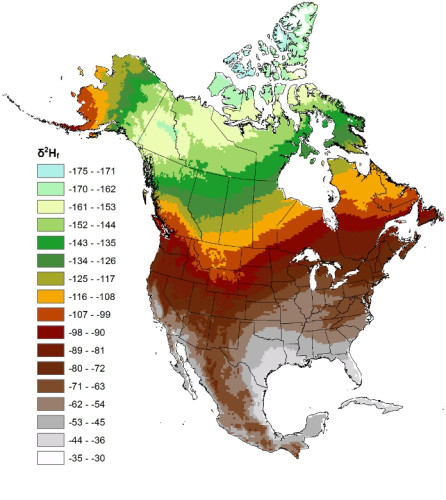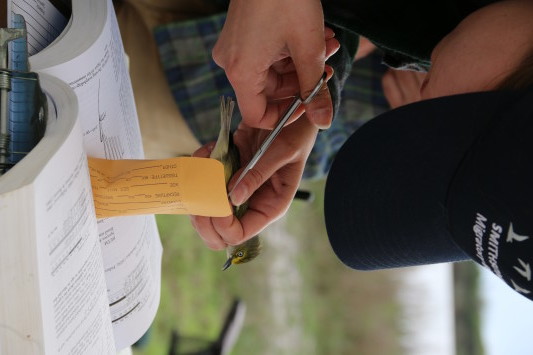HOME | satellite telemetry | acoustic telemetry | geolocators | radio telemetry | motus wildlife tracking system
individual marking | molecular markers | stable isotopes | movement models | future methods
Overview
After several papers calling for more feather sampling and isotopic studies (Hobson 1999, Smith et al. 2003, Hobson et al. 2014), stable isotopes are increasingly used in studies of migratory connectivity.
With their increasing use, there are a number of resources to reference for their applications. A recent book by Hobson and Wassenaar (2018) details the background of the topic, application, and analysis. Several review papers have also covered the use of stable isotopes in marine fishes (Trueman et al. 2012) and birds (Inger and Bearhop 2008).
What are they?
Stable isotopes are non-radioactive forms of elements that have similar chemical properties but vary in their atomic mass due to differences in the number of neutrons. The differences in atomic mass cause separation among isotopes of the same element during geochemical and metabolic processes. This phenomenon is known as isotopic fractionation.
Useful isotopes for migratory connectivity

Hydrogen isoscape of North America used to assign migratory origins to passerines (Figure 2 in Hobson et al. 2015).
Approximately two thirds of the known elements have more than one stable isotope, but isotopes of carbon (13C), nitrogen (15N), and hydrogen (also know as Deuterium, D) are among the most useful for studying migratory connectivity. There are two reasons for this.
- Their patterns of isotopic fractionation are well understood and vary predictably across broad spatial scales.
- They are naturally abundant, allowing them to be be detected in biological tissues.
Each of the aforementioned isotopes offers different clues about a bird’s molt location. Some of the most informative research on migratory connectivity uses multiple stable isotopes or uses stable isotopes in combination with genetic markers.
- Stable-hydrogen isotopes vary strongly with latitude.
- Stable-carbon isotopes show a similar pattern due to broad scale differences in water-use efficiency and photosynthesis strategy by plants.
- Stable-sulfur isotopes differ between marine and terrestrial environments, making it possible to measure longitudinal origins of molt in species whose habitats extend to coastal regions.
Collection

A Smithsonian Migratory Bird Center researcher collects a claw sample to use in stable isotope analysis from a migrating White-eyed Vireo. Photo by Annie Novak.
Feathers (claws, blood and muscle can also be used) are the most commonly used tissue in stable isotope investigations of migratory connectivity. Most species of migratory birds undergo a complete molt once each year between July and September on or near their breeding areas, and the isotopic signatures of foods eaten during this time become incorporated into feathers. Because isotopic signatures are mostly inert once stored in feather tissue, samples collected later on in the year provide information about the geographic origin of birds during molt.
If you have avian tissue samples, you can also consider contributing the sample metadata to the IsoBird Network which collects collects, stores, and provides access to avian samples through a global online platform. Uploading the basic sample metadata will facilitate the sample reuse in stable isotopic ecology. This could yield a broad range of studies including multi-species and large-scale projects and will help create research connections between ornithologists across the globe.
Analysis
Stable isotopes are analyzed using isotope ratio mass spectrometry, and sample results are expressed relative to a standard of known isotopic composition.
Using a variety of approaches strengthens connectivity research. Often an isotopic component would be useful but a scientist is not set up to carry out the analyses in their own lab. More labs are developing the capacity to carry out isotopic analyses of population connectivity. Search for universities, agencies, and companies near you that have stable isotope analysis laboratories.
Edited by Peter Marra (Georgetown Environment Initiative, Peter.Marra@georgetown.edu), 2014.
Updated by Allison Huysman (Migratory Connectivity Project, huysmana@si.edu), 2020.
References
- Hobson, K.A. 1999. Tracing origins and migration of wildlife using stable isotopes: a review. Oecologia 120:314-326.
- Hobson, K.A. and L.I. Wassenaar. 2018. Tracking Animal Migration with Stable Isotopes. Academic Press, London, UK.
- Hobson, K. A., S. L. Van Wilgenburg, E. H. Dunn, D. J. T. Hussell, P. D. Taylor, and D. M. Collister. 2015. Predicting origins of passerines migrating through Canadian migration monitoring stations using stable-hydrogen isotope analyses of feathers: a new tool for bird conservation. Avian Conservation and Ecology 10(1): 3.
- Hobson, K.A., S.L. Van Wilgenburg, J. Faaborg, J.D. Toms, C. Rengifo, A. Llanes Sosa, Y. Aubry, and R. Brito Aguilar. 2014. Connecting breeding and wintering grounds of Neotropical migrant songbirds using stable hydrogen isotopes: a call for an isotopic atlas of migratory connectivity. Journal of Field Ornithology 85(3):237-257.
- Inger, R. and S. Bearhop. 2008. Applications of stable isotope analyses to avian ecology. Ibis 150:447-461.
- Smith, T.B., P.P. Marra, M.S. Webster, I. Lovette, H.L. Gibbs, R.T. Holmes, K.A. Hobson, and S. Rohwer. 2003. A call for feather sampling. The Auk 120:218-221.
- Trueman, C.N., K.M. MacKenzie, and M.R. Palmer. 2012. Identifying migrations in marine fishes through stable-isotope analysis. Journal of Fish Biology 81:826-847.
HOME | satellite telemetry | acoustic telemetry | geolocators | radio telemetry | motus wildlife tracking system
individual marking | molecular markers | stable isotopes | movement models | future methods

